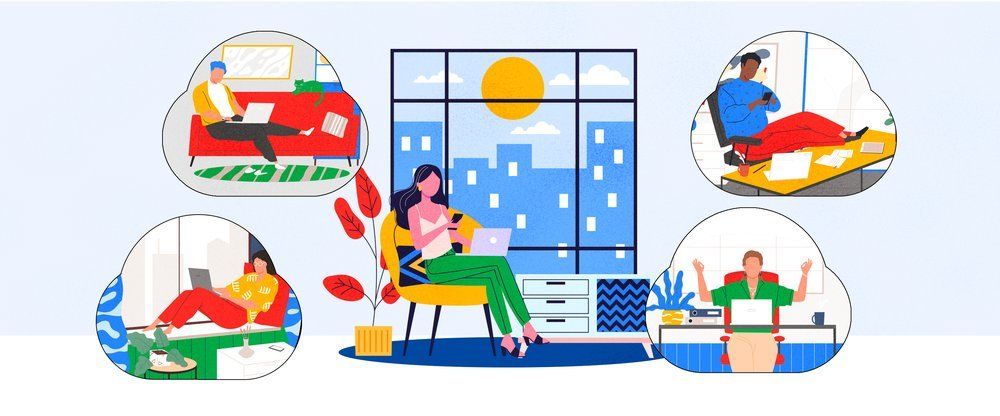Websites are easy! Back in MY day…
 I remember making my first website. It was back in the late 90’s, and at the time if you wanted a website you needed to know how to use HTML. “ H
yper T
ext M
arkup L
anguage” is coding used to create information web browsers can translate. At its core it’s just a bunch of on/off switches that are wrapped around text. For instance, if you want the word “car” to show up in bold, you would surround it with the bold on/off switch like this: < b>car. When viewed in a web browser, it will look like: car
. I was able to use Notepad (the text editor included with Windows) to create my first site using these switches and a few other commands. It had some simple text, a bad music file playing in the background (that was the trendy thing to do back then), animated icons…all done with Notepad. It looked terrible, it took me a week, and I had to learn dozens of complicated HTML tricks to get it going, not to mention learning how to use FTP to move files from my computer to a server on the Internet. Sound complicated? It was. The non-techie person would never be able to do this, and that stigma has stuck to website creation for over a decade: websites are complicated and you need a web guru to make one for you.
I remember making my first website. It was back in the late 90’s, and at the time if you wanted a website you needed to know how to use HTML. “ H
yper T
ext M
arkup L
anguage” is coding used to create information web browsers can translate. At its core it’s just a bunch of on/off switches that are wrapped around text. For instance, if you want the word “car” to show up in bold, you would surround it with the bold on/off switch like this: < b>car. When viewed in a web browser, it will look like: car
. I was able to use Notepad (the text editor included with Windows) to create my first site using these switches and a few other commands. It had some simple text, a bad music file playing in the background (that was the trendy thing to do back then), animated icons…all done with Notepad. It looked terrible, it took me a week, and I had to learn dozens of complicated HTML tricks to get it going, not to mention learning how to use FTP to move files from my computer to a server on the Internet. Sound complicated? It was. The non-techie person would never be able to do this, and that stigma has stuck to website creation for over a decade: websites are complicated and you need a web guru to make one for you.
This is actually no longer true. Advances in web apps have brought forth amazing tools that let anyone, and I do mean anyone , create a website. No HTML coding knowledge needed. If you know how to use a mouse you can point and click your way to publishing on the web. A website is your storefront on the Internet. More people check websites for information than read phone books or read print ads, so a presence on the Internet is a must.
This month, TOAST.net introduces three easy options to make your own website:
1. Do-It-Yourself: Web Presence Builder
We’ve just implemented Web Presence Builder this month and I’m really liking this tool. Creating a website is a simple three-step process:
- Log in to the Website Control Panel.
- Drag and drop modules, type content, and upload pictures into one of the pre-made templates.
- Click the Publish button.
You can have a fantastic looking site up and running in under an hour. The controls are very similar to what you could see in a word processor, the options are intuitive, and it all works very seamlessly. Once you get your feet wet, you can get more advanced by setting up photo galleries, displaying video, adding an online store…all by dragging modules from a menu to your page. This means the first time do-it-yourselfer can get everything created and running quickly, has the power to make changes to the site at anytime, and has room to grow as needs develop.
One of the most impressive features of Web Presence Builder is it’s Social Media sync capability. You can easily add buttons for Facebook, Twitter, LinkedIn, and so forth, and that’s fine, but what made my eyes pop is the Facebook page sync functionality. Facebook is an awesome marketing tool, and it can be a bit complicated getting a Landing Page set up for your business, hobby, or organization. By turning on the Social Media tool, anything you publish to your website gets mirrored on Facebook.
For example, we set up a simple demo website here: http://www.euc.com
I filled in some content, added a TOAST.net menu option at the top, and added a couple of graphics. It took about 10 minutes total. I then turned on the Social Media feature and linked it a Facebook page.
The body of the page and the tabs are now duplicated, and any changes made on the website will automatically sync with Facebook. How cool is that? If you want to make a great website quickly and easily, Web Presence Builder is definitely the way you want to go. Here’s a quick video demonstrating how a website is made. Turn up your speakers because the music will make you smile as much as the creation process:
2. Advanced User: Concrete 5
The second option we’re offering to create your own website is Concrete 5. While offering some of the same features of Web Presence Builder, I would compare the two as a paint-by-numbers kit vs. oil paints and canvas. While you can get the same results from both, Concrete5 will give you more freedom and control over the look of your pages. Geared towards businesses desiring a uniquely stylized site that is easy to edit, Concrete5 is one of the most powerful website construction tools available. You can start with a template, start from scratch, tweak colors and behaviors…it’s completely customizable.
Administration is another strong point of Concrete5. The site administrator can assign people to be in charge of certain pages, allowing for an editing hierarchy. For instance, John may be in charge of sales, so he can edit the “Sales” page. Donna may be in charge of research, so she can update the “Upcoming Products” page. Dave maintains the entire site, so he has access to all pages. This helps keep fresh and useful content flowing, and keeps updates timely since the responsibilities are spread among multiple people.
As mentioned, the interface consists of “modules”, meaning you can pop in boxes for text, slide shows, forms, you name it. Concrete5 has a very extensive library of modules, allowing you to add just about any content in any manner you can think of. Designed for users with some experience in web design, Concrete5 is an awesome choice to get a top notch website up and running quickly.
3. A Third Option: Have It Custom Designed
Even though both Web Presence Builder and Concrete5 give you easy options to create any type of website you may need, some of you out there just don’t have the time or energy. That’s OK too. TOAST.net has a highly skilled design team on staff to help you out. These people are amazing — give them your ideas, pictures, sketches on napkins…anything you have, and they will create a website you can be proud of ( check out some of their previous work! ). Development time on this option takes a while longer obviously, but you get a finished product out the door and training on using your site when it’s done. As always, updates or changes can be made whenever you wish by simply logging in to your site. Nice!
Any Way You Go, No Coding Required
They’ve made publishing a website so easy now that I’m actually a little annoyed that these tools weren’t available back when I started. I remember trying to debug pages of code, getting frustrated, making a work-around, getting frustrated, making a work-around to my work-around, then saying “eh, good enough.” A lot of pro web-designers are feeling too: horror stories of what they used to go through for website development are starting to get as common as grandpa spouting off about “walking 5 miles to school, through 4 feet of snow, up hill, both ways…”.
You kids and your websites today have it so easy.











